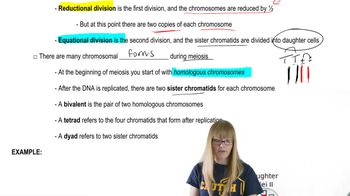What is the probability that, in an organism with a haploid number of 10, a sperm will be formed that contains all 10 chromosomes whose centromeres were derived from maternal homologs?
Table of contents
- 1. Introduction to Genetics51m
- 2. Mendel's Laws of Inheritance3h 37m
- 3. Extensions to Mendelian Inheritance2h 41m
- 4. Genetic Mapping and Linkage2h 28m
- 5. Genetics of Bacteria and Viruses1h 21m
- 6. Chromosomal Variation1h 48m
- 7. DNA and Chromosome Structure56m
- 8. DNA Replication1h 10m
- 9. Mitosis and Meiosis1h 34m
- 10. Transcription1h 0m
- 11. Translation58m
- 12. Gene Regulation in Prokaryotes1h 19m
- 13. Gene Regulation in Eukaryotes44m
- 14. Genetic Control of Development44m
- 15. Genomes and Genomics1h 50m
- 16. Transposable Elements47m
- 17. Mutation, Repair, and Recombination1h 6m
- 18. Molecular Genetic Tools19m
- 19. Cancer Genetics29m
- 20. Quantitative Genetics1h 26m
- 21. Population Genetics50m
- 22. Evolutionary Genetics29m
9. Mitosis and Meiosis
Development of Animal Gametes
Problem 33
Textbook Question
Assume that you were examining a first polar body and noted that it had one copy (dyad) of each chromosome except chromosome 21. Chromosome 21 was completely absent. What would you expect to be the chromosome 21 complement (only with respect to chromosome 21) in the secondary oocyte? What consequences are likely in the resulting zygote if the secondary oocyte was fertilized?
 Verified step by step guidance
Verified step by step guidance1
Understand the context: The first polar body is a byproduct of meiosis I in oogenesis. It typically contains one copy (dyad) of each chromosome that was segregated during meiosis I. If chromosome 21 is absent in the first polar body, it means that chromosome 21 did not segregate properly during meiosis I.
Determine the chromosome 21 complement in the secondary oocyte: Since the first polar body lacks chromosome 21, the secondary oocyte must have retained both copies of chromosome 21 (a condition known as nondisjunction). This means the secondary oocyte will have two copies of chromosome 21 instead of the normal one copy.
Predict the outcome of fertilization: During fertilization, the sperm will contribute one copy of chromosome 21. If the secondary oocyte already has two copies of chromosome 21, the resulting zygote will have three copies of chromosome 21 (trisomy 21).
Explain the consequences of trisomy 21: Trisomy 21 is the genetic basis for Down syndrome, a condition characterized by developmental delays, intellectual disabilities, and specific physical traits. The presence of an extra chromosome disrupts normal gene dosage and development.
Summarize the key points: The absence of chromosome 21 in the first polar body indicates nondisjunction during meiosis I. This results in the secondary oocyte having two copies of chromosome 21. If fertilized, the zygote will have trisomy 21, leading to Down syndrome.
 Verified video answer for a similar problem:
Verified video answer for a similar problem:This video solution was recommended by our tutors as helpful for the problem above
Video duration:
1mPlay a video:
Was this helpful?
Key Concepts
Here are the essential concepts you must grasp in order to answer the question correctly.
Meiosis and Polar Bodies
Meiosis is a specialized type of cell division that reduces the chromosome number by half, producing gametes. In females, this process results in the formation of one functional ovum and polar bodies, which are typically non-functional. The first polar body is a byproduct of meiosis I and may contain an unequal distribution of chromosomes, which can lead to abnormalities in the gametes.
Recommended video:
Guided course

Meiosis Overview
Chromosome Complement
The chromosome complement refers to the complete set of chromosomes present in a cell. In the context of the secondary oocyte, if chromosome 21 is absent in the first polar body, the secondary oocyte would typically have one copy of chromosome 21. This is crucial for understanding the genetic makeup of the resulting zygote after fertilization.
Recommended video:
Guided course

Complementation
Consequences of Chromosomal Abnormalities
When a gamete with an abnormal chromosome number, such as the absence of chromosome 21, is fertilized, it can lead to significant developmental issues in the resulting zygote. In this case, the zygote would be missing chromosome 21, which could result in conditions like Down syndrome or other genetic disorders, depending on the specific chromosomes involved and their roles in development.
Recommended video:
Guided course

Chromosome Structure
Related Videos
Related Practice
Textbook Question
508
views
1
comments


